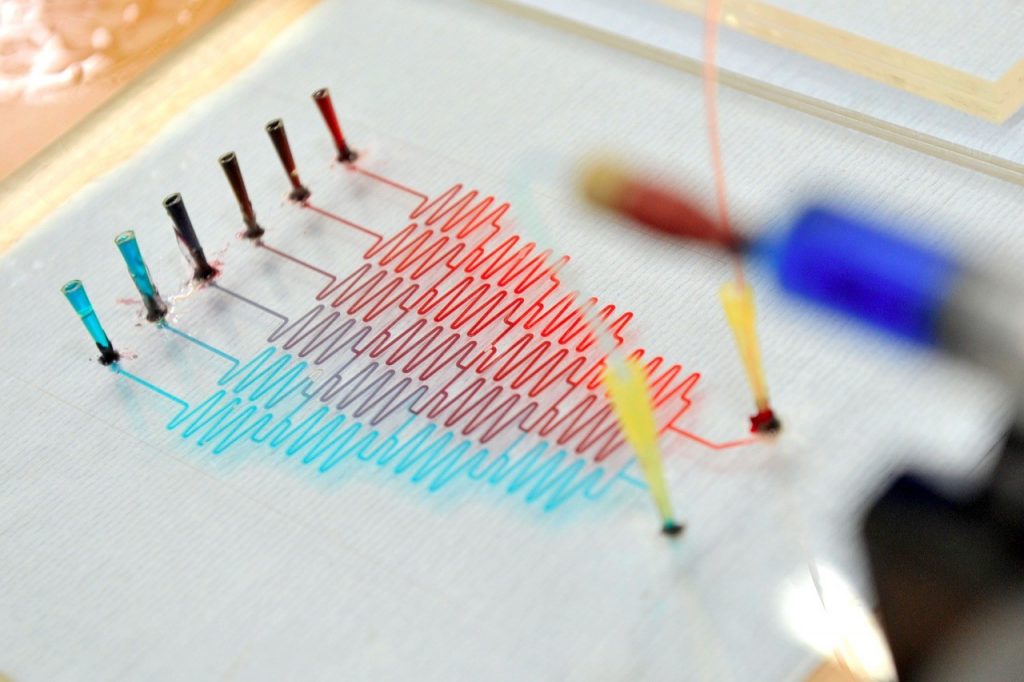From the Journal: Biomicrofluidics
WASHINGTON, D.C., July 9, 2019 — Microfluidics and learning-on-a-chip research — involving the manipulation of small amounts of fluids to run miniaturized experiments in physics, chemistry, biology and medicine — are a prolific research field. But, so far, there aren’t many published examples of how to teach it in an easily understandable way to students or how to communicate the numerous significant advances within the field to public audiences in a relatable manner.

To address this, in the journal Biomicrofluidics, from AIP Publishing, a group of researchers presents a review of published literature about microfluidics education and provides methods and suggestions for anyone who wants to improve their own microfluidics teachings and outreach.
“Science education and outreach are both popular right now, and public outreach is also increasingly important, because taxes fund a significant amount of research,” said Nicole Pamme, at the University of Hull. “Public awareness of scientific advances is important for good policymaking within democratic societies.”
Microfluidics is a term that encompasses a broad range of tools used to manipulate extremely small volumes of fluids, ranging from attoliters (one quintillionth of a liter) to microliters (a microliter is one millionth of a liter; a can of Coke, for example, is 355,000 microliters in volume). This technology is useful, because it allows scientists to miniaturize experiments, which enables lower consumption of chemicals and reagents, smaller sample volumes, and smaller, more portable instrumentation.
“Many experiments can be carried out faster or more efficiently and with precise control of local conditions, which is impossible to achieve in large petri dishes or reaction vessels,” said Darius Rackus, a co-author at ETH Zürich. “One of the goals of microfluidics is to mirror the history and advances of computer science by going from dedicated rooms and facilities for computing to miniaturized, hand-held computers that can be used anywhere for the chemical and life sciences.”
The most common microfluidics format is microchannels, which are essentially small plumbing systems with a width or height of at least 1 to 10 of micrometers. At this length scale, the fluids have a low Reynolds number (the ratio of inertial to viscous forces), which means that they exhibit laminar flow (as opposed to turbulent flow).
“One implication of this is that fluids flowing together don’t mix but rather continue in the direction of flow,” Rackus said. “This is a useful phenomenon that many researchers capitalize on to precisely control the placement of fluids and particles within a microfluidic device.”
In the group’s review, they determined that most examples of including microfluidics with teaching or outreach are broadly split into two categories: teaching about microfluidics or teaching with microfluidics. Many examples of teaching about microfluidics focus on the physics and engineering of microfluidic systems.
“These could be demonstrations that explain concepts, such as flow behavior or design projects, where students create a microfluidic device to solve a particular problem,” said Pamme. “In cases of teaching with microfluidics, we found examples where microfluidics was used more as a means to an end to study physical, chemical or biological phenomena.”
The group hopes more student exposure to microfluidics will increase interest in the multidisciplinary field of microfluidics, and ultimately lead to more researchers in the field.
“We hope that our paper will equip educators to include microfluidics in their curricula — both in playful and serious ways — and to share ideas of how to engage citizens about medicine and clinical diagnostics developments, environmental analysis, chemical synthesis, which are all underpinned by concepts of engineering and physics,” said co-author Ingmar Rieldel-Kruse, at Stanford University. “Given the limited reports within the literature, we’d like to encourage more sharing — either formal or informal — of ideas and activities for teaching microfluidics.”
###
For more information:
Larry Frum
media@aip.org
301-209-3090
Article Title
“Learning on a chip:” Microfluidics for formal and informal science education
Authors
Darius G. Rackus, Ingmar H. Riedel-Kruse and Nicole Pamme
Author Affiliations
ETH Zürich, Stanford University, University of Hull
